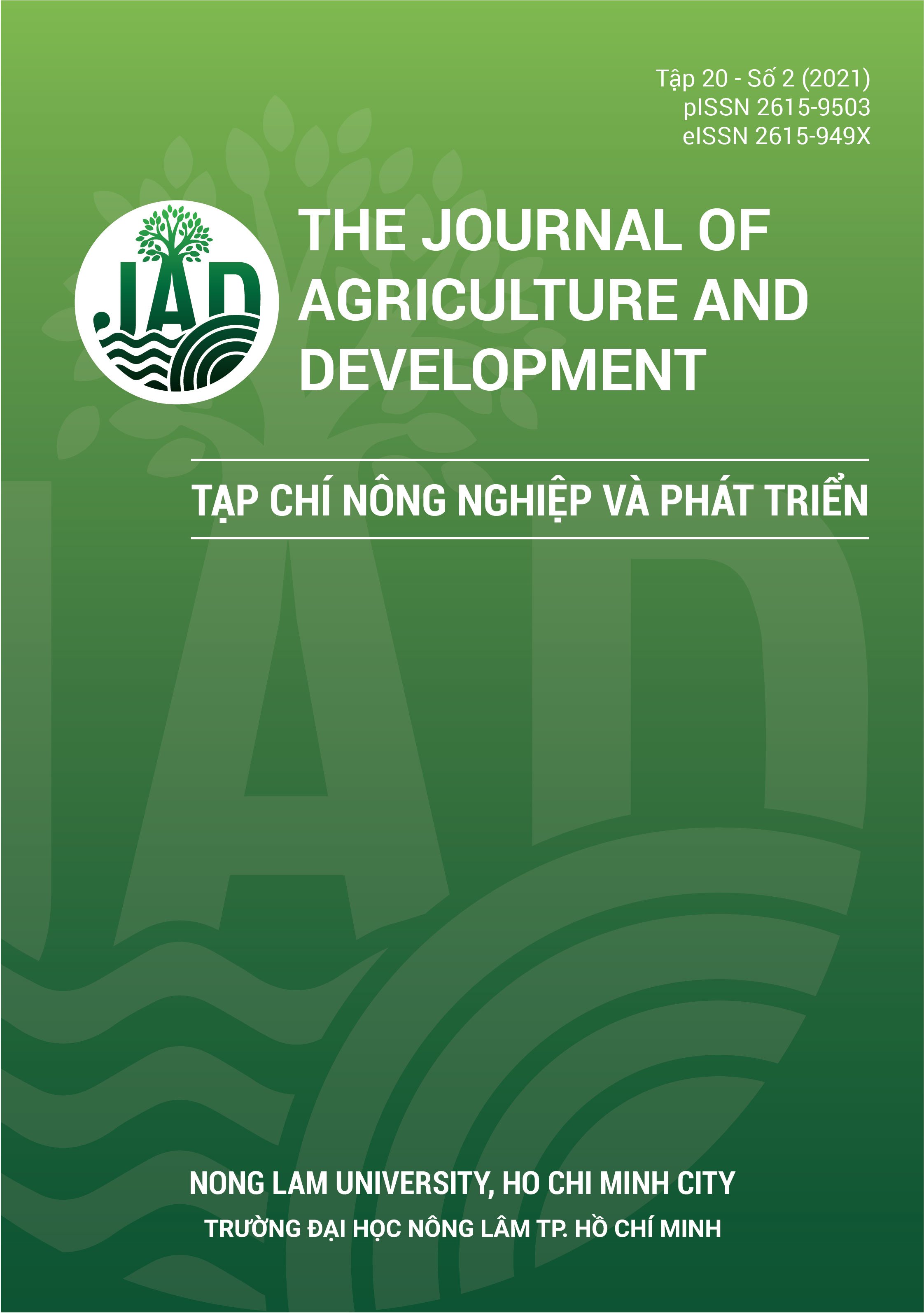Sự phân bố và hiện diện của nấm rễ nội cộng sinh (Vesicular Arbuscular Mycorrhyza) trong vùng đất trồng bưởi Da Xanh tại Bà Rịa Vũng Tàu
Main Article Content
Tóm tắt
Nghiên cứu được thực hiện nhằm xác định sự phân bố và hiện diện của nấm nội cộng sinh VAM (Versicular Arbuscular Mycorrhiza) trong vùng đất quanh rễ và rễ bưởi Da Xanh tại Phú Mỹ, Bà Rịa Vũng Tàu. Các mẫu đất và rễ được thu thập trên các vườn bưởi 6 - 7 năm tuổi, trồng trên 2 nền đất phổ biến tại địa phương, ở 2 tầng đất 0 - 20 cm và 20 - 40 cm, tại 2/3 tán và mép tán. Kết quả cho thấy nấm VAM hiện diện trên nền đất đỏ bazan với mật số bào tử cao hơn trong đất đen, tập trung chủ yếu ở tầng đất mặt (0 - 20 cm) và ở mép tán. Chi Glomus và Acaulospora là 2 chi chiếm ưu thế với tỉ lệ dao động lần lượt trong khoảng từ 53,18 ± 2,59% đến 58,54 ± 0,46% và 23,68 ± 2,96% đến 29,33 ± 0,64%. Càng tăng độ sâu tầng đất, mật số bào tử nấm VAM càng giảm, thành phần các chi nấm cộng sinh cũng thay đổi. Tỉ lệ rễ có sự cộng sinh dao động từ 56,20 ± 3,11% đến 62,00 ± 3,37%, cao nhất trên đất đỏ.
Article Details
Tài liệu tham khảo
BRVT CPPPS (Ba Ria Vung Tau Crop Production and Plant Protection Subdepartment). (2018). Fruit crops production status in Ba Ria Vung Tau (research report). Ba Ria Vung Tau Agriculture and Rural Development Department, Ba Ria Vung Tau, Vietnam.
Cuenca, G., & Lovera, M. (2010). Seasonal variation and distribution at different soil depths of Arbuscular Mycorrhizal fungi spores in a tropical sclerophyllous shrubland. Botany 88(1), 54-64. https://doi.org/10.1139/B09-100
Davies, F. S., & Albrigo, L. G. (1994). Citrus (Crop production science in horticulture) (1st ed.). Oxford, UK: Oxford University Press.
Day, L. D., Sylvia, D. M., & Collins, M. E. (1987). Interactions among vesicular arbuscular mycorrhizae, soil, and landscape position. Soil Science Society of America Journal 51(3), 635-639. https://doi.org/10.2136/sssaj1987.03615995005100030015x
Fidelibus, M. W., Martin, C. A., Wright, G. C., & Stutz, J. C. (2000). Effect of arbuscular mycorrhizal (AM) fungal communities on growth of ’Volkamer’ lemon in continually moist or periodically dry soil. Scientia Horticulturae 84(1-2), 127-140. https://doi.org/10.1016/S0304-4238(99)00112-0
Gadkar, V., David-Schwartz, R., Kunik, T., & Kapulnik, Y. (2001). Arbuscular mycorrhizal fungal colonization. Factors involved in host recognition. Plant Physiology 127(4), 1493-1499. https://doi.org/10.1104/pp.010783
He, X. L., Mouratov, S., & Steinberger, Y. (2002). Spatial distribution and colonization of arbuscular mycorrhizal fungi under the canopies of desert halophytes. Arid Land Research and Management 16(2), 149-160. https://doi.org/10.1080/153249802317304440
Johnson, N. C., Zak, D. R., Tilman, D., & Pfleger, F. L. (1991). Dynamics of vesicular-arbuscular mycorrhizal fungi during old field succession. Oecologia 86, 349-358. https://doi.org/10.1007/BF00317600
Joner, E. J., & Jakobsen, I. (1995). Growth and extracellular phosphatase activity of arbuscular mycorrhizal hyphae as influenced by soil organic matter. Soil Biology and Biochemistry 27(9), 1153-1159. https://doi.org/10.1016/0038-0717(95)00047-I
Kapoor, R., Giri, B., & Mukerji, K. G. (2002). Soil factors in relation to distribution and occurrence of vesicular Arbuscular Mycorrhiza. In Mukerji, K. G., Manoharachary, C., & Chamola, B. P. (Eds.). Techniques in mycorrhizal studies (51-85). Dordrecht, Germany: Springer. https://doi.org/10.1007/978-94-017-3209-3_4
Nguyen, L. T. K., Le, T. T., Nguyen, H. V., & Nguyen, H. H. (2012). A study on Arbuscular Mycorrhiza diversity in soil and orange roots sampled from Quy Hop, Nghe An. Academia Journal of Biology 34(4), 441-445. https://doi.org/10.15625/0866-7160/v34n4.2679
Nguyen, T. T., Tran T. T. T., & Nguyen, H. V. (2017). Distribution of Arbuscular Mycorrhiza fungi (AMF) spores in citrus orchards in Cao Phong district, Hoa Binh province. Journal of Science: Advanced Materials and Devices 33(1S), 235-242. https://doi.org/10.25073/2588-1094/vnuees.4195
Oehl, F., Sieverding, E., Ineichen, K., Ris, E. A., Boller, T., & Wiemken, A. (2005). Community structure of arbuscular mycorrhizal fungi at different soil depths in extensively managed agroecosystems. New Phytologist 165(1), 273-283. https://doi.org/10.1111/j.1469-8137.2004.01235.x
Rayment, G. E., & Lyons, D. J. (2011). Soil chemical methods - Australasia. Collingwood, Australia: Csiropublishing.
Shukla, A., Vyas, D., & Anuradh, J. (2013). Soil depth: an overriding factor for distribution of arbuscular mycorrhizal fungi. Journal of Soil Science and Plant Nutrition 13(1), 23-33. http://dx.doi.org/10.4067/S0718-95162013005000003
Slavich, P. G., & Petterson, G. H. (1993). Estimating the critical conductivity of saturated paste extracts from 1:5 soil: water suspensions and texture. Australian Journal of Soil Research 31(1), 73-81. https://doi.org/10.1071/SR9930073
Solaiman, M. Z., & Hirata, H. (1996). Effectiveness of arbuscular mycorrhizal colonization at nursery stage on growth and nutrition in wetland rice (Oryza sativa L) after transplanting under different soil fertility and water regimes. Soil Science and Plant Nutrition 42(3), 561-571. https://doi.org/10.1080/00380768.1996.10416325
Wang, M., & Jiang, P. (2015). Colonization and diversity of AM fungi by morphological analysis on medicinal plants in Southeast China. The Scientific World Journal (ID 753842). https://doi.org/10.1155/2015/753842.
Wang, P., Zhang, J. J., Shu, B., & Xia, R. X. (2012). Arbuscular mycorrhizal fungi associated with citrus orchards under different types of soil management, southern China. Plant Soil Environment 58(7), 302-308. https://doi.org/10.17221/676/2011-PSE
Wu, Q. S., Zou, Y. N., He, X. H., & Luo, P. (2011). Arbuscular mycorrhizal fungi can alter some root characters and physiological status in trifoliate orange (Poncirus trifoliate L. Raf.) seedlings. Plant Growth Regulation 65, 273-278. https://doi.org/10.1007/s10725-011-9598-6
Zangaro, W., Nisizaki, S. M. A., Domingos, J. C. B., & Nakano, E. M. (2002). Arbuscular mycorrhizal in native woody species of Tibagi River Basin, Paraná. Cerne 8(1), 77-87.








